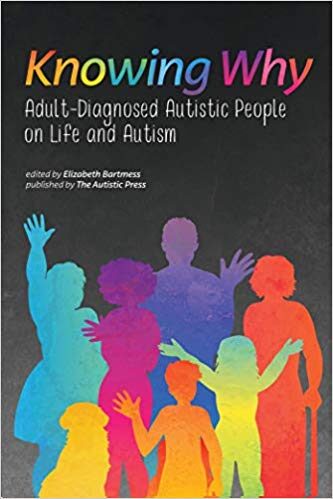Knowing Why is a valuable resource for anyone who has been through the process of being diagnosed or self-diagnosed as autistic in adulthood, anyone who wants to better understand us, and anyone who might be wondering if they might be autistic themselves.
Tag: elizabeth bartmess
Elizabeth Bartmess elizabethbartmess.com Book Cover via GoodReads.com [image: Cover of the book The State of Grace: A medium-green background covered with rows of lighter green happy face emojis tilted sideways, except one pink sad face emoji on the lower right. Large white text in an all-caps informal font reads: “The State of Grace” Smaller text in white script reads, “Rachael Lucas” Smaller white all-caps informal text in the upper right reads, “Sometimes fitting in means standing out.”] The State of Grace is a young adult novel narrated by Grace, a fifteen-year-old high school student who deals with common teenage issues like dating, friendships, family conflict, and birthday parties, while also being autistic in a world not designed for autistic people. Grace is a well-rounded and sympathetic character. She has various interests (horses, wildlife, Doctor Who, My Little Ponies), rides and cares for a horse, has friendships and complex relationships with…
Elizabeth Bartmess elizabethbartmess.com This is a three-part series. Part I explores autistic interiority and neurology. Part II explores Diversity in Autistic Characteristics and Demographics. In Part I of this series, I talked about how good representation of autistic characters shows interiority—characters’ inner experiences and reasons for doing things—and how various aspects of autistic neurology affect our experiences, particularly sensory differences, language and speech differences, social skills and abilities, and our ability to strongly enjoy specific interests. I also briefly mentioned executive function, the usefulness of routines and structures, motor difficulties, and a few other common differences, plus some common co-conditions, and discussed how having these differences, and having to interact with others surrounding them, results in our developing skills and coming to new situations with particular expectations for what will happen. In Part II, I talked about variation among autistic people: we each have a particular constellation of neurological characteristics…
Elizabeth Bartmess elizabethbartmess.com This is a three-part series. Part I explores autistic interiority and neurology. Part III explores Setting, Plot, and Character Growth. In Part I, I talked about how neurological differences affect autistic people’s internal experiences and strategies, and how we change over time as a result. Today, I’ll talk about variation in autistic characteristics, in our and others’ relationship to our diagnosis (or lack of it), and variation in demographics, as well as how others’ perceptions of us influence how they treat us, and how we change in response. On Friday, I’ll bring everything together and add some thoughts and links to advice on writing autistic characters, along with a list of some common aspects of autistic experience that are underrepresented in fiction, plus a list of all the books and short stories I’ve mentioned. Even though autistic people have many things in common, we also vary a…
Elizabeth Bartmess elizabethbartmess.com This is a three-part series. Part II explores Diversity in Autistic Characteristics and Demographics. Part III explores Setting, Plot, and Character Growth. “A lot of writers and actors seem to be able to get their heads around what autism basically is, in terms of language, sensory, and social communication difficulties. But then it’s as if they don’t know, or can’t extrapolate to, the full range of experiences that autistic people actually live. That things have happened to us, and things have happened in certain ways for us all our lives, and those things have had consequences for who we become and who we are….[T]he autistic characters [readers and viewers] are used to seeing have no depth of experience. They are people without history.” —Chavisory, at Chavisory’s Notebook This series is about what autistic characters look like when they’re written well, when they have the depth of experience…
Elizabeth Bartmess runs the autistics-and-cousins autchat discussions on Twitter, and also writes and critiques autism-themed fiction. We talked with Bartmess about why autchat matters, sometimes in surprising ways, and also about why “‘Autistic character learns empathy’ is the character arc I most wish would go away.” Elizabeth Bartmess [image: photo of a white person with short light brown hair and glasses, smiling.] Thinking Person’s Guide to Autism: Tell us about autchat. What is it, exactly? Elizabeth Bartmess: Autchat is a Twitter hashtag by and for autistic people and “autistic cousins”—people who have similar experiences due to other disabilities like hydrocephalus, cerebral palsy, ADHD, etc. We welcome people whether they are formally diagnosed, self-diagnosed, or wondering whether they might be autistic or similar. We have weekly hour-long chats on our experiences, with topics such as accommodations, burnout, and sexuality. During a chat, the moderator asks 4-5 questions and participants answer them.…


